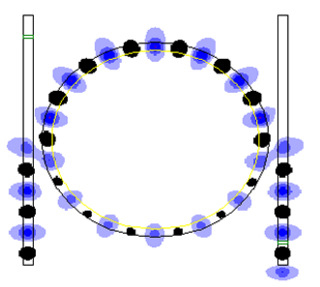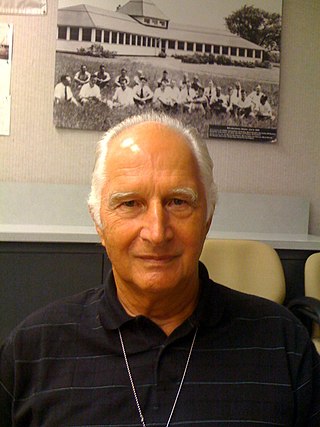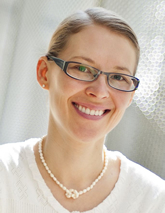Related Research Articles

An optical ring resonator is a set of waveguides in which at least one is a closed loop coupled to some sort of light input and output. The concepts behind optical ring resonators are the same as those behind whispering galleries except that they use light and obey the properties behind constructive interference and total internal reflection. When light of the resonant wavelength is passed through the loop from the input waveguide, the light builds up in intensity over multiple round-trips owing to constructive interference and is output to the output bus waveguide which serves as a detector waveguide. Because only a select few wavelengths will be at resonance within the loop, the optical ring resonator functions as a filter. Additionally, as implied earlier, two or more ring waveguides can be coupled to each other to form an add/drop optical filter.

An optical circulator is a three- or four-port optical device designed such that light entering any port exits from the next. This means that if light enters port 1 it is emitted from port 2, but if some of the emitted light is reflected back to the circulator, it does not come out of port 1 but instead exits from port 3. This is analogous to the operation of an electronic circulator. Fiber-optic circulators are used to separate optical signals that travel in opposite directions in an optical fiber, for example to achieve bi-directional transmission over a single fiber. Because of their high isolation of the input and reflected optical powers and their low insertion loss, optical circulators are widely used in advanced fiber-optic communications and fiber-optic sensor applications.
A photonic integrated circuit (PIC) or integrated optical circuit is a microchip containing two or more photonic components that form a functioning circuit. This technology detects, generates, transports, and processes light. Photonic integrated circuits use photons as opposed to electrons that are used by electronic integrated circuits. The major difference between the two is that a photonic integrated circuit provides functions for information signals imposed on optical wavelengths typically in the visible spectrum or near-infrared (850–1650 nm).
A hybrid silicon laser is a semiconductor laser fabricated from both silicon and group III-V semiconductor materials. The hybrid silicon laser was developed to address the lack of a silicon laser to enable fabrication of low-cost, mass-producible silicon optical devices. The hybrid approach takes advantage of the light-emitting properties of III-V semiconductor materials combined with the process maturity of silicon to fabricate electrically driven lasers on a silicon wafer that can be integrated with other silicon photonic devices.
Silicon photonics is the study and application of photonic systems which use silicon as an optical medium. The silicon is usually patterned with sub-micrometre precision, into microphotonic components. These operate in the infrared, most commonly at the 1.55 micrometre wavelength used by most fiber optic telecommunication systems. The silicon typically lies on top of a layer of silica in what is known as silicon on insulator (SOI).

Nader Engheta is an Iranian-American scientist. He has made pioneering contributions to the fields of metamaterials, transformation optics, plasmonic optics, nanophotonics, graphene photonics, nano-materials, nanoscale optics, nano-antennas and miniaturized antennas, physics and reverse-engineering of polarization vision in nature, bio-inspired optical imaging, fractional paradigm in electrodynamics, and electromagnetics and microwaves.

A slot-waveguide is an optical waveguide that guides strongly confined light in a subwavelength-scale low refractive index region by total internal reflection.

Michael Hochberg is an American physicist. He’s authored over 100 peer-reviewed journal articles, has founded several companies, and has been an inventor on over 60 patents. Hochberg's research interests include silicon photonics and large-scale photonic integration. He has worked in a number of application areas, including data communications, biosensing, quantum optics, mid-infrared photonics, optical computing, and machine learning. Much of his work in silicon photonics has been the product of a longstanding series of collaborations with Thomas Baehr-Jones.
Michal Lipson is an American physicist known for her work on silicon photonics. A member of the National Academy of Sciences since 2019, Lipson was named a 2010 MacArthur Fellow for contributions to silicon photonics especially towards enabling GHz silicon active devices. Until 2014, she was the Given Foundation Professor of Engineering at Cornell University in the school of electrical and computer engineering and a member of the Kavli Institute for Nanoscience at Cornell. She is now the Eugene Higgins Professor of Electrical Engineering at Columbia University. In 2009 she co-founded the company PicoLuz, which develops and commercializes silicon nanophotonics technologies. In 2019, she co-founded Voyant Photonics, which develops next generation lidar technology based on silicon photonics. In 2022, Lipson was a co-founder of Xscape photonics to accelerate AI, ML, and simulation hardware. In 2020 Lipson was elected the 2021 vice president of Optica, and she served as the Optica president in 2023.

Amnon Yariv is an Israeli-American professor of applied physics and electrical engineering at Caltech, known for innovations in optoelectronics. Yariv obtained his B.S., M.S. and PhD. in electrical engineering from University of California, Berkeley in 1954, 1956 and 1958, respectively.

Herwig Kogelnik is an Austrian-American electrical and optical engineer. He is best known for his fundamental contributions to the developments in laser technology, optoelectronics, photonics and lightwave communications systems. His work over a 40-year career at Bell Labs earned him the Marconi Prize, the IEEE Medal of Honor, the National Medal of Technology and many other awards.

A hybrid plasmonic waveguide is an optical waveguide that achieves strong light confinement by coupling the light guided by a dielectric waveguide and a plasmonic waveguide. It is formed by separating a medium of high refractive index from a metal surface by a small gap.
Integrated quantum photonics, uses photonic integrated circuits to control photonic quantum states for applications in quantum technologies. As such, integrated quantum photonics provides a promising approach to the miniaturisation and scaling up of optical quantum circuits. The major application of integrated quantum photonics is Quantum technology:, for example quantum computing, quantum communication, quantum simulation, quantum walks and quantum metrology.
Jelena Vučković is a Serbian-born American professor and a courtesy faculty member in the Department of Applied Physics at Stanford University. She served as Fortinet Founders Chair of the Department of Electrical Engineering at Stanford University from August 2021 through June 2023. Vučković leads the Nanoscale and Quantum Photonics (NQP) Lab, and is a faculty member of the Ginzton Lab, PULSE Institute, SIMES Institute, and Bio-X at Stanford. She was the inaugural director of the Q-FARM initiative. She is a Member of the National Academy of Sciences, and a Fellow of The Optical Society, the American Physical Society and the Institute of Electrical and Electronics Engineers.

Alexandra Boltasseva is Ron And Dotty Garvin Tonjes Distinguished Professor of electrical and computer engineering at Purdue University, and editor-in-chief for The Optical Society's Optical Materials Express journal. Her research focuses on plasmonic metamaterials, manmade composites of metals that use surface plasmons to achieve optical properties not seen in nature.

Keren Bergman is an American electrical engineer who is the Charles Batchelor Professor at Columbia University. She also serves as the director of the Lightwave Research Laboratory, a silicon photonics research group at Columbia University. Her research focuses on nano-photonics and particularly optical interconnects for low power, high bandwidth computing applications.
Hon Ki Tsang is the Dean of the Faculty of Engineering of the Chinese University of Hong Kong and the Wei Lun Professor of Electronic Engineering at The Chinese university of Hong Kong. His research expertise is in photonic integrated circuits and silicon photonics.
Amy Carole Foster is an American engineer who is an associate professor in the Department of Electrical and Computer Engineering at Johns Hopkins University. Her work considers nonlinear optics and silicon-based photonic devices.
Sasikanth Manipatruni is an American engineer and inventor in the fields of Computer engineering, Integrated circuit technology, Materials Engineering and semiconductor device fabrication. Manipatruni contributed to developments in silicon photonics, spintronics and quantum materials.
Dirk Robert Englund is an Associate Professor of Electrical Engineering and Computer Science at the Massachusetts Institute of Technology. He is known for his research in quantum photonics and optical computing.
References
- ↑ "Director". www.mpi-halle.mpg.de. Retrieved 2020-10-29.
- 1 2 "The Optical Society Elects Lipson 2021 Vice President". www.photonics.com. Retrieved 2020-10-29.
- 1 2 "Director At Large - Joyce Poon Profile". The Optical Society .
- ↑ "Poon J | Electrical & Computer Engineering". www.ece.utoronto.ca. Retrieved 2020-10-29.
- ↑ Poon, Joyce Kai See (2007). Active and Passive Coupled-Resonator Optical Waveguides (phd thesis). California Institute of Technology.
- ↑ "Milton and Francis Clauser Doctoral Prize Recipients" (PDF). Caltech Graduate Office. Retrieved 2020-10-29.
- ↑ Sacher, Wesley D.; Poon, Joyce (2008). "Dynamics of microring resonator modulators". Optics Express . 16 (20): 15741–15753. Bibcode:2008OExpr..1615741S. doi: 10.1364/OE.16.015741 . PMID 18825213.
- ↑ Sacher, Wesley D.; Poon, Joyce K. S. (2009-09-01). "Characteristics of Microring Resonators With Waveguide-Resonator Coupling Modulation". Journal of Lightwave Technology. 27 (17): 3800–3811. Bibcode:2009JLwT...27.3800S. doi:10.1109/JLT.2009.2016852. S2CID 45736062.
- ↑ Caspers, J. N.; MacKay, A. W.; Poon, J. K. S. (March 2012). "Short efficient non-adiabatic spot-size converters by mode interference in silicon-on-insulator waveguides". Ofc/Nfoec: 1–3.
- ↑ Sacher, Wesley D.; Huang, Ying; Lo, Guo-Qiang; Poon, Joyce K. S. (2015-02-15). "Multilayer Silicon Nitride-on-Silicon Integrated Photonic Platforms and Devices". Journal of Lightwave Technology. 33 (4): 901–910. Bibcode:2015JLwT...33..901S. doi:10.1109/JLT.2015.2392784. S2CID 29411701.
- ↑ Sacher, Wesley D.; Luo, Xianshu; Yang, Yisu; Chen, Fu-Der; Lordello, Thomas; Mak, Jason C. C.; Liu, Xinyu; Hu, Ting; Xue, Tianyuan; Guo-Qiang Lo, Patrick; Roukes, Michael L.; Poon, Joyce K. S. (2019). "Visible-light silicon nitride waveguide devices and implantable neurophotonic probes on thinned 200 mm silicon wafers". Optics Express . 27 (26): 37400–37418. Bibcode:2019OExpr..2737400S. doi:10.1364/OE.27.037400. PMC 7046040 . PMID 31878521.
- ↑ Moreaux, Laurent C.; Yatsenko, Dimitri; Sacher, Wesley D.; Choi, Jaebin; Lee, Changhyuk; Kubat, Nicole J.; Cotton, R. James; Boyden, Edward S.; Lin, Michael Z.; Tian, Lin; Tolias, Andreas S. (2020-10-14). "Integrated Neurophotonics: Toward Dense Volumetric Interrogation of Brain Circuit Activity—at Depth and in Real Time". Neuron. 108 (1): 66–92. doi: 10.1016/j.neuron.2020.09.043 . ISSN 0896-6273. PMC 8061790 . PMID 33058767. S2CID 222350075.
- ↑ "Stabsstelle Kommunikation, Events und Alumni: Medieninformation Nr. 227/2018". www.pressestelle.tu-berlin.de. Retrieved 2020-10-29.
- ↑ "Joyce Poon". CRANIA. Archived from the original on 2020-09-29. Retrieved 2020-10-29.
- ↑ "2018 OSA Fellows". The Optical Society. Retrieved 2020-10-29.
- ↑ "ANNUM 2013". Issuu. 18 December 2013. Retrieved 2020-10-29.
- ↑ "Joyce Poon, 35 Innovators Under 35 winner, 2012". MIT Technology Review. Retrieved 2020-10-29.
- ↑ "Toronto researchers among MIT's 35 top innovators". thestar.com. 2012-08-21. Retrieved 2020-10-29.
- ↑ "TR35 - Joyce Poon's schedule for EmTech MIT". emtechmit2012.sched.com. Retrieved 2020-10-29.